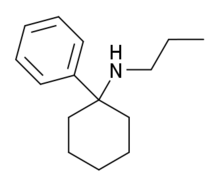Chemistry:Phencyclamine
From HandWiki
 | |
| Clinical data | |
|---|---|
| ATC code |
|
| Legal status | |
| Legal status |
|
| Identifiers | |
| |
| CAS Number | |
| ChemSpider | |
| Chemical and physical data | |
| Formula | C15H23N |
| Molar mass | 217.349 g/mol g·mol−1 |
| 3D model (JSmol) | |
| |
| |
| (verify) | |
Phencyclamine or PCPr is an arylcyclohexylamine dissociative anesthetic drug with hallucinogenic and stimulant effects. It is around the same potency as phencyclidine, although slightly less potent than its ethyl homologue eticyclidine,[1] and has reportedly been sold as a designer drug in Germany and other European countries since the late 1990s.[2][3]
Several other related derivatives have also been encountered, with the n-propyl group of PCPr replaced by a 2-methoxyethyl, 2-ethoxyethyl or 3-methoxypropyl group to form PCMEA, PCEEA and PCMPA respectively.[4][5][6]
References
- ↑ "THE SYNTHESIS OF PHENCYCLIDINE AND OTHER 1-ARYLCYCLOHEXYLAMINES". Journal of Medicinal Chemistry 8: 230–5. March 1965. doi:10.1021/jm00326a019. PMID 14332667.
- ↑ "Metabolism and toxicological detection of a new designer drug, N-(1-phenylcyclohexyl)propanamine, in rat urine using gas chromatography-mass spectrometry". Journal of Chromatography A 1186 (1-2): 380–90. April 2008. doi:10.1016/j.chroma.2007.11.002. PMID 18035363.
- ↑ Christoph Sauer. Phencyclidine Derivatives – A new Class of Designer Drugs. Studies on the Metabolism and Toxicological Analysis. Universität des Saarlandes, 2008
- ↑ "New designer drugs N-(1-phenylcyclohexyl)-2-ethoxyethanamine (PCEEA) and N-(1-phenylcyclohexyl)-2-methoxyethanamine (PCMEA): Studies on their metabolism and toxicological detection in rat urine using gas chromatographic/mass spectrometric techniques". Journal of Mass Spectrometry : JMS 43 (3): 305–16. March 2008. doi:10.1002/jms.1312. PMID 17968862.
- ↑ "Investigations on the cytochrome P450 (CYP) isoenzymes involved in the metabolism of the designer drugs N-(1-phenyl cyclohexyl)-2-ethoxyethanamine and N-(1-phenylcyclohexyl)-2-methoxyethanamine". Biochemical Pharmacology 77 (3): 444–50. February 2009. doi:10.1016/j.bcp.2008.10.024. PMID 19022226.
- ↑ "Metabolism and toxicological detection of the designer drug N-(1-phenylcyclohexyl)-3-methoxypropanamine (PCMPA) in rat urine using gas chromatography-mass spectrometry". Forensic Science International 181 (1-3): 47–51. October 2008. doi:10.1016/j.forsciint.2008.09.001. PMID 18922655.


